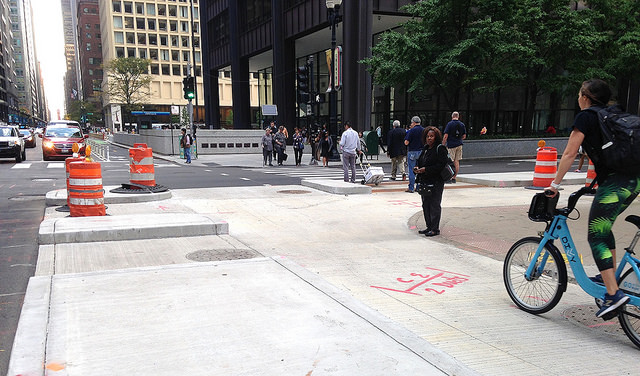I doubt any bikeway engineer in the Netherlands would want to take responsibility for inspiring this. https://t.co/kswznAjI0g
— Transitized (@transitized) November 30, 2016
And even the Green Lane Project, the nation’s leading cheerleader for protected bike lanes, was curious why the concrete islands were placed at the northwest corner, rather than the southwest. That’s the main location where there there’s a potential for conflicts between bikes and motor vehicle, since drivers have to cross the bike lane to make a left turn.
I responded that there are dedicated signal phase for northbound bike riders and turning drivers, so the Chicago Department of Transportation may have felt that further protection wasn’t necessary. In addition, I noted, there used to be an issue with pedestrians at the northwest corner standing in the Dearborn lane while waiting for a walk signal, so the pedestrian islands provide a safe place to stand.
I checked in with Mike Amsden, who manages CDOT’s bikeway program, to get the skinny on why islands were installed at the northwest corner but not the southwest corner. “The intersection concept is provided at this location to mostly assist with people riding west on Randolph who want to turn south on Dearborn,” he responded via email. “The corner refuge island provides a protected space for a person to queue on Dearborn facing south, outside of the path of people continuing west on Randolph. The pedestrian refuge islands also provide space for pedestrians to queue outside of the bike lane, and in a place much more visible to motorists.”
Amsden added that the same treatment wouldn’t work at the southwest corner because there is no "dead space" outside of a travel lane, turn lane, or the two-way bike lane where the concrete could be installed. “If the corner refuge island was shifted straight south to the southwest corner it would be directly in line with left turning motor vehicle traffic from northbound Dearborn to westbound Randolph, and directly in line with westbound traffic on Randolph in the southern most curb lane.”
“Your response… re: the left hook is spot on,” Amsden said. “The signal separation for through bike and turning car traffic provides the protection.” He acknowledged that drivers do occasionally disregard their signal. “But we know from experience in Chicago and elsewhere that the dedicated signals increase compliance for both people riding and people turning left -- over 90% compliance for both (not perfect for either, but huge improvements).”
This morning one more reason for installing concrete protection at the northwest corner occurred to me. There were at least three incidents in recent years in which speeding drivers crashed into Petterino’s restaurant, located at that corner. That hasn’t happened since the Dearborn lane was installed, but you can never be too careful.





